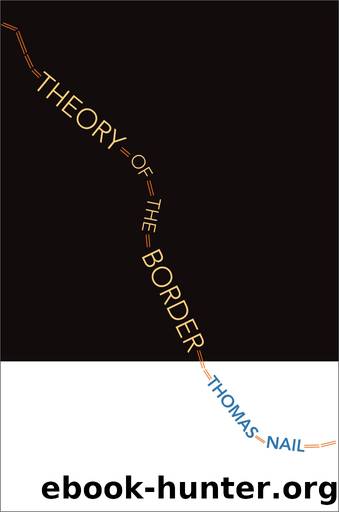Theory of the Border by Nail Thomas;

Author:Nail, Thomas;
Language: eng
Format: epub
Publisher: Oxford University Press USA - OSO
Published: 2016-07-15T00:00:00+00:00
INFORMATION CHECKPOINT
The third major type of modern border is the information checkpoint. In contrast to offensive police borders and defensive security borders, information borders have a unique boundary or binding function: they compel or bind social flows together as assemblages of data points. A data point is an isolated bit of social flow—a location, a name, a color, a date—that is used to divide and arrange the passage of social flows. For modern boundaries these data points become the keys or codes required for social circulation. The informational checkpoint aims less at stopping, enclosing, or blocking than at collecting and redirecting flows of data. While medieval boundaries were defined by the time-space-activity matrix or grid of the timetable, modern boundaries are instead defined by the oscillation and redirection of collections of data.59 Instead of enclosing the individual into spatial temporal activity cells—“Now here do this, now there do that”—modern boundaries are much more open and fluid. The aim is not to physically bind individuals into and between enclosed times and spaces, but to produce a kinetic environment such that data groupings (individuals) regulate themselves according to the boundaries of their informational complex: traffic will follow the path of least resistance on its own; trade will move to the most profitable areas on its own, water, food, waste, and all social flows will move just like water flowing downhill toward natural basins. Thus the question of modern boundaries is how to manage a kinetic milieu such that data flows and pools in the most desirable places. In other words, modern limology is a question of social landscaping based on an informational topography—no longer simply a coordinate matrix or cartography, but a topological surface with trajectories, slopes, and curves.
The creation of information and its binding together into social bodies in motion is a form of social division or bordering. First, points of information are extracted from the continuous flow of social movement. These points can be geographical, political, biological, educational, and so on. They can be any point whatever. Second, these points are attached to or bound to one another to create a unit or individual in motion. The mobile individual does not preexist the binding process but is a product of it: the person is bound by it. The person is an “in(fo)dividual.” Informational boundaries define individuality but are also the codes that allow the individual to move and pass. As we have seen in the previous sections, the police record, trace, and bind social motion according to these points. Property deeds, national identity cards, photo portraits, passports, and so on are all composed of informational points—assembled and bound to a mobile body. Although precursors to data borders exist in previous historical periods, such as ancient writs or medieval identification cells, information is not the same as identification. Identification produces a cellular, individual person, and links the person to centers of juridical power. Information, on the other hand, is punctual, deindividualized, and oscillatory across national and international administrations. The period beginning
Download
This site does not store any files on its server. We only index and link to content provided by other sites. Please contact the content providers to delete copyright contents if any and email us, we'll remove relevant links or contents immediately.
The Secret History by Donna Tartt(18159)
The Social Justice Warrior Handbook by Lisa De Pasquale(11951)
Thirteen Reasons Why by Jay Asher(8451)
This Is How You Lose Her by Junot Diaz(6435)
Weapons of Math Destruction by Cathy O'Neil(5829)
Zero to One by Peter Thiel(5488)
Beartown by Fredrik Backman(5356)
The Myth of the Strong Leader by Archie Brown(5237)
The Fire Next Time by James Baldwin(5016)
How Democracies Die by Steven Levitsky & Daniel Ziblatt(4954)
Promise Me, Dad by Joe Biden(4908)
Stone's Rules by Roger Stone(4857)
100 Deadly Skills by Clint Emerson(4690)
A Higher Loyalty: Truth, Lies, and Leadership by James Comey(4550)
Rise and Kill First by Ronen Bergman(4545)
Secrecy World by Jake Bernstein(4388)
The David Icke Guide to the Global Conspiracy (and how to end it) by David Icke(4380)
The Farm by Tom Rob Smith(4323)
The Doomsday Machine by Daniel Ellsberg(4245)
